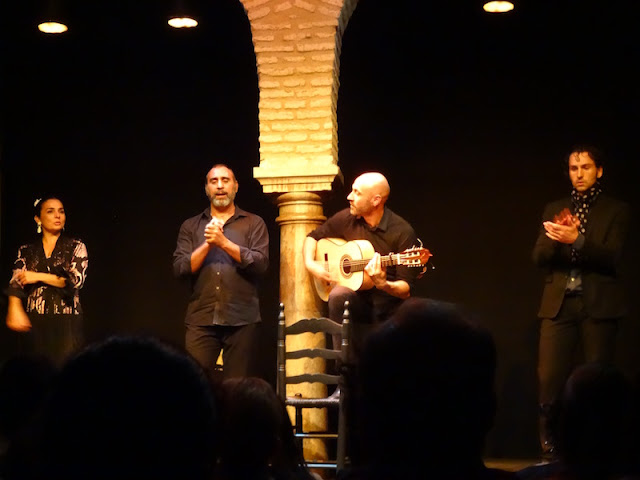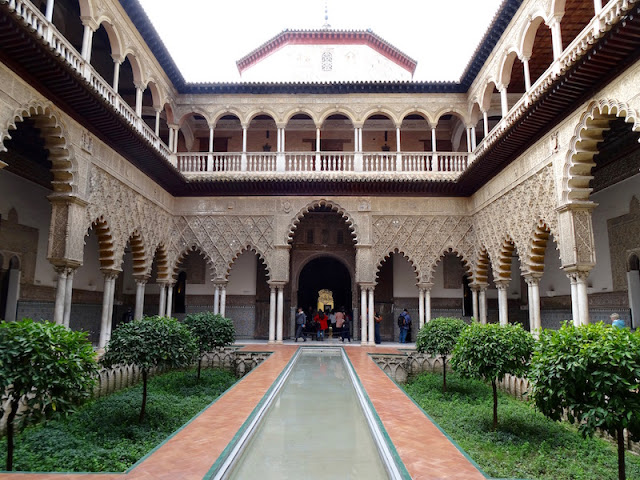The view was very foggy as we departed Cordoba at 8.45 am, for the 2 1/2 hour coach journey to Seville. The journey took us through rolling hills and acres of olive groves. We arrived at our hotel, situated just off a narrow, one way, alley. There was much horn blowing as Frank scrambled around in the taxi, looking for his wallet. Thankfully I found it. It had slipped down into the side pocket. The driver was paid, the traffic moved on and peace was restored.
At reception, we were welcomed with a glass of champagne, which was greatly received given the short drama outside.
The Hotel Corrigidor, close to the Alameda [Mall] de Hercules, was another fantastic find by Frank, comfortable, friendly, spacious, great location.
Alameda de Hercules.
RHS - view from our room to the narrow alley.
Nic, Frank's mate of over 50 years, wasn't arriving from Geneva until about 5 pm, so we set out to find the Guadalquivir River and the stunning, white bridge we had spotted driving into Seville.
The Alamillo bridge was completed in 1992 for the 1992 World Expo. It is a cantilever spar cable-stayed bridge, designed to create a bridge of symbolic importance. It represents the soaring aspirations of the City of Seville.
During the 3 days we were here, we again found delightful alleys and al fresco eating.
Mates catching up at the Moorish themed Restaurant, Cuna 2 on Calle Cuna. Fantastic food, decor and service.
A short distance away from the restaurant, was the dramatic, wooden structure, Metropole Parasol. Designed by a German, made from birch from Finland, concrete and steel, it is held together by glue. Completed in 2011, it consists of 6 parasols in the form of giant mushrooms and in its lower level is an archaeological museum preserving Roman houses, discovered at the beginning of the project. Built in the old market square of the old city, it is in stark contrast to its historic surroundings.
Another evening we found a tiny restaurant, in an alley off the Alameda de Hercules. Lovely food, but memorable for me, was the size of the sangria I ordered.
Walking back through the Alameda de Hercules, we discovered that a stage had been set up and groups of men were singing Spanish folk songs, accompanied by only one or two guitars and or a mandolin. They wore pantaloons and black cloaks covered in badges. We spent over an hour listening to their wonderful melodic tones, but were unable to discover anything of their story. Googling has proved negative.
Many kilometres were covered as we explored the city over the next 3 days.
Columbus Monument [built 2014] with his ship 'Santa Maria' in the Murillo Gardens, adjacent to the Alcazar Gardens.
Rodrigo de Triana aboard La Pinta, shouted "Tierra! Tierra!" [land, land], at 2am on October 12, 1492. Triana was not given recognition for his discovery.
Columbus' tomb in the Cathedral.
A glimpse through a gate.
Street flamenco.
Paid flamenco.
Returning from the flamenco dancing, the street lighting and atmosphere on a Saturday evening was incredible. The Spanish really do know how to relax and spend time with family and friends.
Fascinating buildings whereever we walked.
Behind this archway is our first glimpse of one of the stunning end towers, of the majestic Plaza Espana, built as the centrepiece and administrative office of the World Fair held in in Seville in 1929. We hadn't a clue of the extent and grand scale of this amazing complex that we were about to see.

Here is our second glimpse of the tower and we are still completely unaware of the scale of things to come.
It was impossible for my camera to even begin to capture the splendour of this semi circular plaza and building.
A panorama from my I-phone.
As seen on google maps.
The complex is decorated with the azulejos or painted ceramic tiles, found throughout Seville. The complex however, is most famous for the 58 benches lining the facade of the main building, which depict allegorical paintings representing each province of Spain.
The expansive gardens of the Maria Luisa Park opposite, were a delight to walk through.
Seville's Cathedral, Santa Maria de la Sede took 100 years to construct. 1401 - 1506. It was built over the site of the Alijama mosque built in the late 12th C. The Cathedral's bell tower [103 m] was the Giralda or minaret of the mosque and dominated the skyline for over 800 years. I spotted it from many different angles.
The tower has a ramp made of 35 segments to elevate one to near the top of the tower. It was wide and tall enough to allow a person to ride a horse to the top.The Christians added a final stairway of 17 steps up to the bells.
The Seville cathedral is the largest gothic cathedral in the world and its size and grandeur is imposing.
From the top of the Giralda, we had 360 degree views of this vast city.
Top L - immediately behind the cathedral roof top is the Alcazar. Top R - the roof top and Patio de los Naranjos or courtyard for the Moorish worshippers to wash their hands and feet.
Bottom L - the old bull ring Bottom R - Alamillo Bridge and Metropole Parasol
The Royal Alcazar of Seville has a history similar to that of Granada and Cordoba. Below is an excerpt from http://www.seville-traveller.com/alcazar-seville/ which succinctly tells its story.
"History
Soon after the Almohades, a Moorish dynasty, gained control of Seville in 1161, they embarked on a building frenzy. They constructed a number of baths, towers, a lavish grand mosque and a fortress-like palace known as the Al-Muwarak (the Blessed).
In 1364, after the Reconquista - the reconquest of Moorish Spain by Christians - King Pedro I commissioned the construction of a new palace, the Palacio Pedro I, at the site of the Al-Muwarak. Craftsmen from across Andalusia created a magnificent interior in Mudéjar style, arranged around a number of patios. Over the years, other monarchs kept expanding the palace, resulting in a diverse complex with different architectural styles. The top floor of the palace is still actively used by the Royal Family."

Ceiling of the Hall of the Ambassadors.


Beauty of a window - 2nd shot, same window, but a different light.


The Alcazar gardens were beautiful in their own way, but not as stunning as in Granada and Cordoba.

On our last night we dined where the locals ate, but inside.










































Holy Mackerel, Helen! What a wonderful tour of Say- vee- ya. The second picture inside the Cathedral was jaw-dropping. Wonderful--a post I will come back to. Oh yes-- thanks for your nice words today.
ReplyDeleteAmazing buildings and so much history! Loved your tour of Seville.
ReplyDeleteWe loved Seville. It was orange season. We saw the Parasol under construction. Not sure I like the result :). I remember those wonderful views from the top of the Giralda.
ReplyDeleteAmazing architecture... and yet my favourite photos are the ones of the gardens and the three of your clearly enjoying your time. :)
ReplyDeleteThe Parasol... hmm. May I say it looks awful? The birch wood must be good though. :D
Thank you very much for sharing. The photos are fabulous.
You really are filling my bucket list with places to see. Another fabulous Spanish city
ReplyDelete